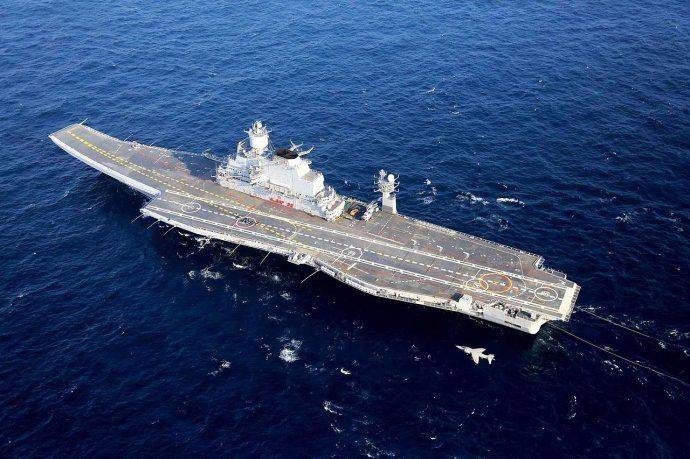Not long ago, the aircraft carrier formation of the Chinese Navy’s Liaoning ship leaped into the Western Pacific for a long-sea patrol. The destroyers of the U.S. Navy tracked and monitored the Liaoning fleet at close range. However, the Liaoning ship ignored the malicious tracking of the United States and carried out carrier-based aircraft take off as usual, and even the J-15 carrier aircraft passed the US destroyer at low altitude.

From the video taken by the US Navy, a J-15 carrier-based aircraft landed steadily on the flight deck of the Liaoning ship. On the rear flight deck of the Liaoning ship, there are parked eight J-15 carrier-based aircraft, in addition to Zhi-9 search and rescue helicopters and Zhi-8 carrier-based helicopters. This clearly shows the state of the Liaoning ship performing combat missions at any time. Under this deck standby aircraft configuration, the Liaoning ship can release a wave of 8 J-15 carrier-based aircraft at any time to conduct sea assault missions. There are also 2 J-15s capable of escorting air defense patrols and direct -9 search and rescue helicopters. For emergency search and rescue when the fighter was released, the Zhi-8 helicopter carried out anti-submarine and radar warning.
At the take-off point on the front deck of the Liaoning ship, there is also a J-15 carrier-based aircraft on standby for take-off at any time. Careful netizens have discovered that every time the Liaoning ship deploys a J-15 ready to take off on the front deck, there will always be a flipped “board” standing behind the ship. What is this for?

The scientific name of this board is the deflector, also known as the “flame baffle”. The deflector is a key component of the aircraft carrier deck aviation protection system. When placed in parallel, it is a part of the flight deck. It has all the functions of the deck, and personnel and equipment can pass from above; and when it is erected to work, it must face the tail of the aircraft. The high-temperature and high-speed flame of the flame washes away.
The deflector can block the tail flame of the carrier-based aircraft when it takes off. Before the carrier-based aircraft takes off, the jet engine is already running at full speed. At this time, it jets a stream of high-temperature and high-speed gas backward, which is very harmful to the aircraft and personnel behind it. The deflector is not placed vertically when in use, it is usually opened at an angle of 60 degrees. This placement method can refract and deflect the gas at the rear of the F-15 to the greatest extent, thus ensuring the least impact on other carrier aircraft.
There is a big difference from my country’s Liaoning ship. The Indian aircraft carrier Chao Riwang does not have a take-off deflector (flame baffle). Some netizens discovered that the Indian aircraft carrier Super Sun King did not have a take-off flame shield. When the MiG-29 carrier aircraft took off, the rear flight deck had to be emptied.

The “Super Sun King” is a good rear independent mast of the aircraft carrier, and this aircraft carrier immediately rises tall, because the American Nimitz-class aircraft carrier is also such a mast. Every time I see a new Indian carrier-based aircraft landing, I feel that my heart is tight and tight, and I am quite worried that the Indian pilot will hit the ship island head-on.

The Indian aircraft carrier “Chaoriwang”, formerly the Gorshkov aircraft carrier built in the Soviet era, is equipped with the Yak-38 vertical take-off and landing carrier aircraft, because the Yak-38 is a vertical take-off and landing, and only needs to take off and land. The flight deck at the point needs to be reinforced and treated with high temperature resistance. No deflector plate is required, so no deflector plate is installed.
When the Gorshkov was refitted, in order to save trouble and cost, Russia did not suggest that India install a deflector, and India actually agreed.

The deflector is taken off and landed by 6 crank arms. The copper pipe under the plate introduces 400 tons of seawater per minute for rapid cooling. The board can be lowered from 400 degrees to 150 degrees in 2 minutes, and the second plane can be smoothly laid down. Taxi to the take-off point. The deflector can guide the tail flame to both sides and above, preventing the jet flame from the fighter jet from scorching the deck and other carrier-based aircraft behind it, and it can also ensure that the take-off area and the landing area do not interfere with each other. It is conducive to deploying more carrier-based aircraft on the deck, and can also quickly release carrier-based aircraft.

It looks like a small deflector, but the structure is actually very complicated. In order to cool down quickly, the deflector shows that it is coated with a high-temperature resistant coating, and the back is water-cooled. There are many huge copper pipes behind the deflector, and the water pump drives a lot of seawater here. Circulate the flow to reduce the temperature of the deflector itself. Such a board integrates the functions of heat insulation, non-slip, and impact resistance. In addition, since the deflector has been in service in the marine environment for a long time, it should also have corrosion resistance. The deflector board needs to simultaneously solve many technologies such as board surface lifting, high temperature resistance, seawater circulating cooling, and maintaining flatness with the runway. The design is very complicated and not easy.

A close-up of the combination of the brake wheel block and deflector of the Liaoning ship.

When the Russians modified the Gorshkov for India, if the deflector was installed, an opening was required on the deck, and water cooling and driving equipment were installed below. Copying the aircraft carrier Kuznetsov does not work either. It requires a whole new set of modified designs, and the cost must be high. Therefore, the Russian side deliberately “forgot” the deflector of the aircraft carrier. Fortunately, India did not force it, so everyone was happy and stopped.

The “Choriwang” aircraft carrier lacking a “drift plate” made the carrier aircraft very awkward when it took off. Its long take-off point is very far behind, behind the carrier fuselage is the sea, and the hot tail flames emitted by the carrier aircraft are directly discharged outboard, so deflectors are not needed. The short take-off point on the front deck is no way. When the MiG-29 takes off, the rear deck must be cleared. But at the same time, the short take-off point is usually on standby, which is in contradiction with deck shutdown operations. So in fact, there is only one real take-off point for this aircraft carrier in India.

In addition, it is reported that the Vikrant, the first domestically-made aircraft carrier in India, does not have a flame shield. Why is this? India does not need it, or is it technically restricted. But since this new aircraft carrier is a brand of IWC, there should be no shortage of this technology. Is it because the Ganges River has a better cooling effect?





























































You must log in to post a comment.